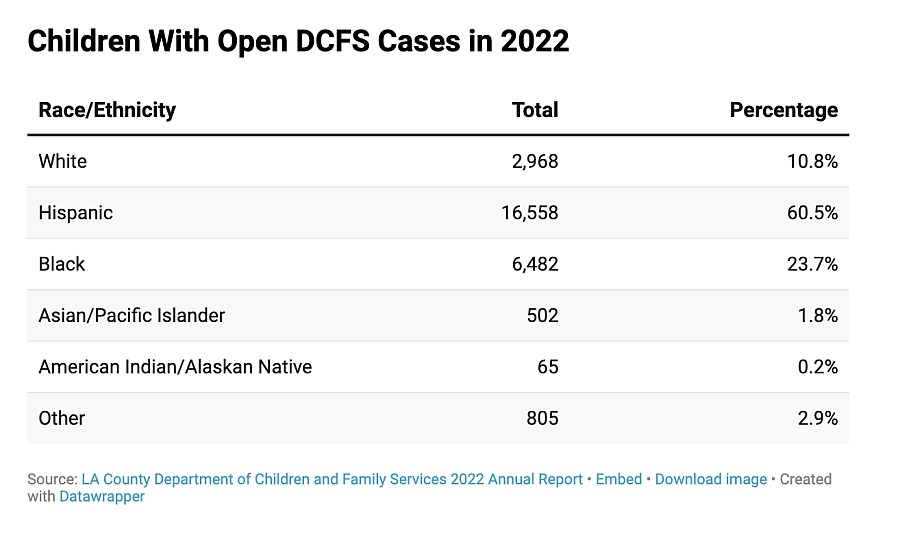Punishing Families: The Need To Reimagine Child Welfare In LA County
The story was originally published in Witness LA with support from our 2022 California Impact Fund.

Princess Dale.
(Image courtesy of Princess Dale)
Part 1: Removed for Neglect
This is the first in a multi-part series about racial and economic disparities in LA County’s child welfare system, and the impact family surveillance and separation has on kids and their parents.
In 2017, six months after 29-year-old Princess Dale had her fourth child, her ongoing problems with her ex, the baby’s father, began to escalate.
After Dale broke up with her boyfriend, he refused to help provide for their child’s material needs. He was punishing her for leaving him, she said.
Dale, who lives in a low-income apartment complex in the Antelope Valley, the northernmost part of LA County, said her baby’s father began threatening her.
On one occasion, Dale said, he told her that their son didn’t need a mother.
Other times, he would come over drunk and “talking crazy,” she told WitnessLA. “He would get mad when I wouldn’t let him in.”
One day, the ex smashed the front windows of her home with his fist.
She called the Los Angeles County Sheriff’s Department Palmdale station. While Dale’s ex had fled by the time the LASD arrived, deputies tracked the man down and arrested him. According to the incident report, Dale’s ex was in the emergency room of the Palmdale Regional Medical Center receiving treatment for a three-inch laceration he acquired in the course of shattering Dale’s windows.
Dale said she called the sheriff’s department in part for safety’s sake, but also because she hoped to guard against any accusations that she was putting her children in potential danger.
Dale knew multiple moms who, after dealing with incidents of domestic violence, found themselves accused of neglect by the LA County Department of Child and Family Services (DCFS), the largest regional child welfare agency in the nation.
The emotional impact of her ex’s increasingly aggressive actions, combined with the fiscal stress of receiving no child support, and suddenly having to pay to replace her windows, left Dale unable to sleep most nights.
The situation, Dale said, was exacerbated by the fact that she was experiencing postpartum depression.
One night, Dale was feeling more distressed than usual. She thought maybe she just needed to vent. She didn’t want her children to see her upset, so she asked her then-boyfriend and her sister, who was visiting at the time, to watch her kids while she walked to the home of a friend who lived three doors down. (Two of the four children Dale had by that time, three-year-old twins, were not present. They were with their father.)
“I go down the hall. I’m overwhelmed, I’m crying. I haven’t slept in days, this man’s still harassing me,” she said. “I ended up having a mental breakdown.”
At her friend’s house, as she was describing her ex’s wrongdoings, her sobbing turned into screaming.
The two women were in an apartment complex, so neighbors heard the commotion, became concerned, and called 911.
When sheriff’s deputies arrived at approximately 12:30 in the morning, Dale’s mental state worsened. “I don’t know if it was the beeping of their walkie talkies or the lights or what,” but she suddenly feared for her life, she said. “I felt the police were going to kill me. So, I started throwing stuff out the window at them.”
While Dale doesn’t remember much else from that night, an ambulance eventually transported her to the hospital. There, Dale was placed on a 72-hour psychiatric hold, officially known as a 5150, for the relevant section of the California Welfare and Institutions Code.
When Dale woke up multiple hours later, she said she found DCFS forms on the table next to her hospital bed. She would later learn that she had signed documents giving social workers permission to take her children. “I don’t even remember being interviewed.”
DCFS staff, she said, had come to the hospital, “when I wasn’t in my right mind, and I was medicated.”
When Dale got home from her three-day psychiatric hold, her boyfriend confirmed that DCFS had taken her children from him after she was taken to the hospital.
“Why’d you let them in?” Dale recalled asking her partner. The social workers came with the police, he said.
“They woke my boyfriend and my children up in the middle of the night to take my kids and give them to strangers,” Dale said.
Before her children could return home, a social worker told Dale she would have to take a drug test. The test results came back showing Dale had marijuana in her system.
“I provided a marijuana card,” she said.
But, according to Dale, the social worker told her they could not accept her medical marijuana card because medical use was not legal at the federal level.
“That doesn’t make sense,” Dale told the social worker. “DCFS is a county government agency.”
Yet, the combination of the marijuana use and a mental health crisis gave DCFS staff what they needed to accuse Dale of neglecting her children.
According to California Family Code § 7827, if a parent “suffers a mental incapacity or disorder that renders the parent unable to care for and control the child adequately,” that parent can be denied custody.
Dale told WLA that, except for the 5150, she had never been hospitalized for mental health as an adult. She had, however, been diagnosed as a child with bipolar disorder and ADHD, when she was in foster care herself. (Dale was in foster care from the age of 11 to 19, because of her own mother’s mental illness.)
WitnessLA has learned from experts, and other mothers that the use of a childhood mental health diagnosis as a factor in finding a parent unfit to raise their children is not uncommon.
“It’s entirely in keeping with the overarching philosophy of family policing; that all ‘abuse’ and ‘neglect’ is due to a psychological failing of the parent,” said Richard Wexler, child welfare expert and Executive Director of the National Coalition for Child Protection Reform.
In addition, social workers repeatedly brought up in court the fact that Dale, herself, was in foster care for eight years. DCFS, when calculating a family’s risk score to determine the likelihood that children will be mistreated, considers a parent’s history of maltreatment as a child to be a risk factor.
When DCFS opened the case against Dale, her three-year-old twins were already with their dad, a previous partner of Dale’s.
The children who were at her house that night, Dale’s five-year-old and six-month-old sons were briefly placed in foster care before being given to their respective fathers. For the baby, this meant living with the man who had been terrorizing Dale.
The five-year-old was sent to Texas to live with a father he did not know, as he and Dale had broken up before his birth.
While she regained shared custody of her kids after eight months, the separation had already caused mother and children serious harm, according to Dale. And, this wasn’t the last time DCFS would intervene in the lives of this mother and her children.
Disparities in the data
In Los Angeles County, as in much of the rest of the nation, social workers investigate Black families like Dale’s at rates disproportionate to their share of the population.
A 2021 report revealed that approximately 58 percent of all Black children in LA County will live through a child maltreatment investigation before they reach the age of 18.
In 2022, the LA County Department of Children and Family Services received reports alleging that 134,940 children were being abused and/or neglected. From those allegations, DCFS opened cases for a total of 27,380 kids. This number includes children who remained at home with their parents while DCFS surveilled their lives, and kids who were placed in foster care.
Last year in Los Angeles County, Black children comprised 23.7 percent of the kids with open DCFS cases], despite making up just 7.4 percent of the county’s kids.
Kids labeled Hispanic also had slightly higher rates of DCFS involvement than their 57.9 percent share of the child population. These children made up 60.5 percent of the 27,380 kids with open cases.

Together, families of color made up at least 84.2 percent of the families whom DCFS decided needed intervention.
Meanwhile, white kids comprised 20.2 percent of the county’s children, but made up 10.8 percent of open DCFS cases. Kids in the Asian/Pacific Islander category made up 10.9 percent of children in the county, and just 1.8 percent of kids with open DCFS cases.

Approximately .2 percent (65 kids) experiencing DCFS intervention were listed as American Indian/Alaska Native, matching their .2 percent of LA County’s kid population. Another 2.9 percent of kids with open DCFS cases were categorized as “other.”
Types of maltreatment
California breaks down allegations of child maltreatment into eight categories: physical abuse, emotional abuse, sexual abuse, exploitation, caregiver absence/incapacity, general neglect, severe neglect, and situations where a kid is at risk because a sibling has been abused.
In 2022, 10.9 percent of kids referred to DCFS were alleged victims of sexual abuse, 16.3 percent were referred to DCFS for physical abuse, 16.5 percent for emotional abuse, and 19.7 percent of kids fell into the category of “at risk, sibling abused.”
Another .2 percent of children were referred for sexual “exploitation,” and 1.1 percent were referred for “caregiver absence/incapacity.”
The allegation most often used when referring kids to the child welfare system is “general neglect,” which DCFS identifies as the reason 34.3 percent of just under 135,000 kids were referred to the agency.
In LA County, just 1.1 percent of DCFS referrals involved “severe neglect” allegations.
General vs. severe
State law defines “severe neglect” as a situation in which a child’s health is endangered. This would include extreme malnutrition or “medically diagnosed nonorganic failure to thrive.” This highest level of neglect includes situations where a parent “willfully causes or permits” the endangerment of their child, including “intentional failure to provide adequate food, clothing, shelter, or medical care.”
Just one percent of the kids referred to DCFS are believed to have experienced this level of intentional neglect.
“General neglect” is defined by state law as “the negligent failure of a parent/guardian or caretaker to provide adequate food, clothing, shelter, or supervision where no physical injury to the child has occurred but the child is at substantial risk of suffering serious physical harm or illness.” In the case of general neglect, the parents are not accused of intentionally putting their kids in harm’s way.
As of last year, the law also states that “‘general neglect’ does not include a parent’s economic disadvantage.”
This is due to the fact that, in 2022, Governor Gavin Newsom signed a bill meant to narrow the definition of “general neglect,” to reduce the number of children removed from their families for conditions of poverty. The bill, AB 2085, amended the relevant section of the penal code to state that kids must be at serious risk of harm or illness, for a parent’s care to rise to the level of “general neglect.”
It’s not yet clear what effect the bill will have on referrals to DCFS and subsequent removals, but “general neglect” has long cast a wide net.
"General neglect” is used as a catchall category for conditions that don’t rise to the level of “severe neglect.”
Using this allegation, social workers take children from parents who use drugs, from parents experiencing mental illness, and from parents who are victims of domestic violence, from parents unable to provide adequate food and other necessities, and from parents who leave kids home alone because they have no childcare (and sometimes a combination of these factors).
“No matter what reason DCFS or its counterparts have for removing a child, when the reason is flimsy they'll always say "it wasn't [fill-in-the-blank] alone," said the National Coalition for Child Protection Reform’s Richard Wexler.
“General neglect” events are often situations in which DCFS is not removing children in critically dangerous environments, but from families for whom additional fiscal resources would likely resolve the family’s most pressing problems.
This was the case for many of the parents WLA spoke with for this series.
Yet, instead of receiving financial aid and community-level support, DCFS often subjects parents and their children to the trauma of separation. From that point on, families face an extremely difficult road to reunification.
When mothers experiencing domestic violence call the police for help, they find that responding law enforcement officers are quick to involve DCFS. Once involved, social workers do often remove children from their homes, even if the victim has left the partner who is abusing them.
These cases, in which a parent is victimized — and the child is not physically hurt — are also categorized as general neglect, because the abused parent has “failed to protect” the child from potential harm.
Knowledge of this possibility, and other potentially negative outcomes often leaves victims of domestic violence afraid to call the police for help, when they need it.
In a 2015 study from the National Domestic Violence Hotline, two-thirds of surveyed survivors who called the police for help said they were somewhat or extremely afraid to call the police in the future. Just 14 percent of respondents who said they had called the police in the past said they were extremely likely to call the police for help again.
Investigated for domestic violence
In 2020, another Black mother in the Antelope Valley lost her children after her then-boyfriend violently attacked her in front of her kids while they were at his house.
An argument started when Lacie — who asked that her name be changed for this story — mentioned she wanted to go to the funeral of one of her best friends.
Her boyfriend “wasn’t taking it seriously, he was joking about it, and I was really grieving,” Lacie said.
The argument escalated. “He punched me, and then he started choking me,” she said. “I tried to fight back, scratch him, punch him, anything.”
Lacie had to call for her oldest kids, a 7-year-old girl and a 6-year-old boy to call 911. “I was scared,” Lacie said. “I was really scared.”
The boyfriend then hit Lacie’s 6-year-old, she said, bruising his face. Eventually, Lacie was able to gather her kids, including a baby she shared with her boyfriend, to run outside the house and call for help.
Her boyfriend followed her, telling his neighbors, who had come out to see what was going on, to “stay out of it.”
So, “they stayed out of it,” Lacie said.
Lacie, who was barefoot, then ran to the main street, where she was able to flag down a car.
The driver, a construction worker, took Lacie and her children back to their own house.
After she and her children arrived home safely, Lacie chose not to report the attack to the police. She was afraid of losing her children.
She lost them anyway after her six-year-old son told his teacher — a person mandated by law to report suspected child abuse or neglect — that his mom and her boyfriend had been fighting and he was scared.
This triggered a DCFS investigation, and Lacie’s children were ultimately taken under the “general neglect” allegation.
Princess Dale, whose children were removed because of mental illness and marijuana use, was also accused of “general neglect.” Other mothers WLA interviewed lost their children for reasons DCFS considered neglectful, but not so problematic as to rise to the level of “severe neglect.”
Another Black mother, whose story will appear later in the series, lost her children after she tested positive for drugs while giving birth to her youngest child in 2020. In addition to the drug use, DCFS also used a childhood bipolar diagnosis to argue that she was unfit to parent her children, she said. In this way, her story paralleled that of Princess Dale.
(Both moms are now in their 30s. In the decades since they were children, diagnosing bipolar disorder in kids has become highly controversial.)
Statistically, Black mothers and their infants are more likely to be drug tested before and after birth than babies and mothers of other races.
According to an April 2023 research paper published in the JAMA Health Forum, Black people are more likely to be drug tested during the birthing process than white people, despite not being more likely than mothers of other races to test positive for drugs.
The threat of prenatal and postnatal drug testing, often a fast track to DCFS involvement, can make mothers too afraid to get medical care while pregnant. This was certainly the case for one mother whose story we’ll share later in the series.
In her book, Torn Apart: How the Child Welfare System Destroys Black Families and How Abolition Can Build a Safer World, author Dorothy Roberts writes that child welfare agencies inaccurately blame “parental pathologies” rather than structural inequities for the harms children experience.
“Overloading the system with children who could remain safely with their parents means that caseworkers have less time and money to find and follow the children truly in danger of severe abuse and neglect,” Roberts writes.
Spending large amounts of government money to intervene in and surveil the lives of families where such intervention is not needed, means there’s less money to support families who mostly need help, according to Roberts.
This worsens “the conditions that can lead to serious maltreatment,” she writes. “Overzealous CPS authorities scare away families who might have sought help for domestic violence and other problems before they spiraled into deadly situations.”
Part Two of this series will look at the LA County neighborhoods where social workers are taking the most kids for general neglect — and the neighborhoods where they are hardly taking any.

